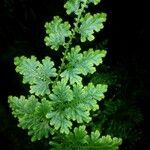Plants terrestrial, evergreen, scandent, 100-200 cm or more. Rhizophores restricted to lower part of main stem or up to upper part, with some spinelike protuberances at base (as well as at axes of stems). Main stems branched from near base upward, stramineous or reddish, 2.4-3.5 mm in diam. in lower part, angulate, sulcate, glabrous; primary leafy branches 5-15 pairs, 3 times pinnately branched, ultimate branches simple or forked, branchlets sparse and regular, adjacent primary branches on main stem 6-13 cm apart, ultimate branches 3-7 mm wide including leaves. Axillary leaves on main stems obviously larger than those on branches, oblong, biauriculate (auricles larger than those of Selaginella helferi); axillary leaves on branches symmetrical, oblong or oblong-elliptic, 1.5-2.4 × 1-1.6 mm, base biauriculate, margin entire. Dorsal leaves asymmetrical, those on main stems obviously larger than those on branches; dorsal leaves on branches approximate to imbricate, overlapping at leaf apex, falcate, 0.9-1.4 × 0.4-0.6 mm, not carinate, base obliquely subcordate, margin entire, apex obtusely cuspidate. Ventral leaves asymmetrical, those on main stem obviously larger than those on branches; ventral leaves on branches slightly ascending or spreading, distant or approximate, oblong-falcate, 2.8-4 × 1-1.5 mm, margin entire, apex obtuse; acroscopic base with rounded auricle, not overlapping stem and branches. Strobili solitary, terminal, compact, tetragonal, 5-35 × 1.8-3.8 mm; sporophylls unlike sterile leaves, uniform, white-margined, suborbicular, margin entire, apex acute or cuspidate; megasporophylls in middle on lower side of strobilus; microsporangia orbicular, rather thin, cells regular; microspores pale yellow, megaspores whitish.
More
Plants terrestrial, vinelike or shrublike. Stems high-climbing, many times branched, branches 4--5-forked, flat, not articulate, glabrous. Rhizophores borne on upperside or underside of stems throughout stem length, 2--3 mm diam. Leaves delicate, papery. Lateral leaves distant, iridescent, blue-green, ovate to oblong, (2.5--)3--4 X (1--)1.5--2 mm (leaves on tertiary stems ± 1/3 smaller); basiscopic base rounded, acroscopic base with whitish, long, downward-curving auricle; margins transparent (whitish and shiny when dry), entire; apex rounded or obtuse. Median leaves falcate-lanceolate or oblique-ovate, 2.4--2.7 X 0.9--1.3 mm; base auriculate, outer auricle larger than inner; margins transparent, entire; apex obtuse. Strobili solitary, 0.5--2 cm; sporophylls monomorphic, cordate to ovate-deltate, base glabrous, margins green, entire, apex slightly cuspidate. 2 n = 20.
An erect and climbing fern. The stems are erect and wiry. It climbs to 7 m long. The main stem is smooth and pale yellow. Along this there are much branched triangle shaped fronds. There are 2 kinds of leaves. The leaves on the fronds are blue-green with a metallic shine.
A tropical plant. It needs moist, shaded conditions. In Indonesia it grows from sea level to 1,200 m above sea level. In China it grows in forests and under shrubs between 100-1,000 m above sea level.



